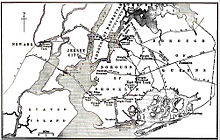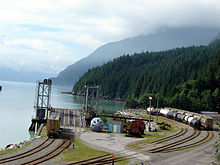Unpowered barge with railroad tracks mounted on its deck
A railroad car float in the Upper New York Bay , 1919. A tugboat (towboat ) stack is visible behind the middle car. 1912 PRR map showing the Greenville Terminal and its car float operations, also the current crossing A railroad car float or rail barge is a specialised form of lighter [ 1] railway tracks mounted on its deck used to move rolling stock across water obstacles, or to locations they could not otherwise go. An unpowered barge , it is towed by a tugboat or pushed by a towboat .
This is distinguished from a train ferry , which is self-powered.
Historical operations
U.S. East Coast
During the Civil War , Union general Herman Haupt , a civil engineer, used huge barges fitted with tracks to enable military trains to cross the Rappahannock River in support of the Army of the Potomac .[ 2]
Beginning in the 1830s, the Baltimore and Ohio Railroad (B&O) operated a car float across the Potomac River , just south of Washington, D.C. , between Shepherds Landing on the east shore, and Alexandria, Virginia on the west. The ferry operation ended in 1906.[ 3] Baltimore Inner Harbor until the mid-1890s. It connected trains from Philadelphia to Washington, D.C., and points to the west. The operation ended after the opening of the Baltimore Belt Line in 1895.[ 3]
The Port of New York and New Jersey had many car float operations, which lost ground to the post-World War II expansion of trucking , but held out until the rise of containerization in the 1970s.[ 4]
These car floats operated between the Class 1 railroads terminals on the west bank of Hudson River in Hudson County, New Jersey and the numerous online and offline terminals located in Brooklyn , Queens , Staten Island , the Bronx , and Manhattan .[ 5] [ 6] New York Harbor area providing car float services were:
As well as the offline terminal railroads :
Car float service was also provided to many pier stations and waterfront warehouse facilities (that did not engage in car floating service directly) by the above-mentioned railroads.
At their peak, the railroads had 3,400 employees operating small fleets totalling 323 car floats, plus 1,094 other barges , towed by 150 tugboats between New Jersey and New York City .
Abandoned float bridges are preserved as part of this history at:
Several other abandoned but unrestored float bridges exist in other locations around New York Harbor. A complete list is available at
Surviving Float Bridges of New York Harbor
The Bay Coast Railroad formerly operated a 2-barge car float connecting Virginia 's Eastern Shore with the city of Norfolk, Virginia across the Chesapeake Bay .
U.S. Midwest
An Erie tugboat and barge on the Chicago River in 1917 Between 1912 and 1936, the Erie Railroad operated a car float service on the Chicago River in Chicago, Illinois .[ 33]
U.S. West Coast
Canada
Woodfibre, British Columbia Car float in Howe Sound Prince Rupert, British Columbia – Whittier, Alaska (Aquatrain [ 34] Various inland lakes of British Columbia (Okanagan [citation needed , Arrow [citation needed , Kootenay )[citation needed (Canadian National Railway and CPR )
Port Maitland, Ontario – Erie, Pennsylvania (TH&B Navigation Company )Port Burwell, Ontario – Ashtabula, Ohio (CN)Cobourg, Ontario – Rochester, New York (Ontario Car Ferry Company )Sarnia, Ontario – Port Huron, Michigan – rail-barge – (CN, until the opening of the Paul Tellier Tunnel ). The rail ferries Pere Marquette 12 Pere Marquette 10 were converted to barges (PM 10 in 1974, PM 12 in the 1980s) and used until 1995 to carry dangerous cargoes and oversize cars.[ 35] Windsor, Ontario – Detroit, Michigan (Grand Trunk , CN, CPR, Michigan Central , Wabash , until the 1980s)[citation needed BC Rail . until 1955 railcars were barged from North Vancouver to Squamish .A large number of isolated BC pulp mills had chemicals and freight moved by car floats.
In the Victoria Harbour to Ogden Point [ 36] [ 37]
Existing operations
Alaska
The Alaska Railroad provides the Alaska Rail Marine rail barge service from downtown Seattle to Whittier on the central Alaskan mainland.[ 38] Aquatrain Prince Rupert, British Columbia to Whittier.[ 39] [ 34]
The car float docks at Bay Ridge , Brooklyn , New York . The only remaining car float service in operation in the Port of New York and New Jersey is operated by New York New Jersey Rail . This company, operated by the bi-state government agency Port Authority of New York & New Jersey is the successor to the New York Cross Harbor Railroad. Car float service operates between 65th Street / Bay Ridge Yard in Brooklyn and Greenville Yard in Jersey City, New Jersey .[ 40] freight cars do not run in the East River Tunnels nor the North River Tunnels (under the Hudson River ), in part due to inadequate tunnel clearances of the New York Tunnel Extension .
See also
References
^ Lederer, Eugene H. (1945). Port Terminal Operation: Port Terminal Management, Stevedoring, Stowage, Lighterage and Harbor Boats . New York, NY: Cornell Maritime Press. pp. 291– 292. ^ Wolmar, Christian (2012). Engines of War . London: Atlantic Books. p. 49. ISBN 9781848871731 ^ a b Harwood, Herbert H. Jr. (1979). Impossible Challenge: The Baltimore & Ohio Railroad in Maryland . Baltimore, MD: Barnard, Roberts. ISBN 0-934118-17-5 ^ Cudahy, Brian J. (2006). Box Boats: How Container Ships Changed the World 45–47 . ISBN 0-8232-2568-2 ^ Flagg, Thomas R. (2000). New York Harbor Railroads in Color, Volume 1 . Scotch Plains, NJ: Morning Sun Books. ISBN 1-58248-082-6 ^ Flagg, Thomas R. (2002). New York Harbor Railroads in Color, Volume 2 . Scotch Plains, NJ: Morning Sun Books. ISBN 1-58248-048-6 ^ Flagg, 2000, pp. 16–23.
^ Flagg, 2002, pp. 26–29.
^ Flagg, 2000, pp. 24–33.
^ Flagg, 2002, pp. 38–39.
^ Flagg, 2000, pp. 34–45.
^ Flagg, 2002, pp. 40–51.
^ Flagg, 2000, pp. 46–55.
^ Flagg, 2002, pp. 52–57.
^ Flagg, 2000, pp. 56–61.
^ Flagg, 2002, pp. 58–63.
^ Flagg, 2000, pp. 62–65.
^ Flagg, 2002, pp. 64–67.
^ Flagg, 2000, pp. 66–83.
^ Flagg, 2002, pp. 68–93.
^ Flagg, 2000, pp. 84–91.
^ Flagg, 2002, pp. 94–97.
^ Flagg, 2000, pp. 92–101.
^ Flagg, 2002, pp. 98–109.
^ Flagg, 2002, pp. 110–116.
^ Flagg, 2000, pp. 118–125.
^ Flagg, 2002, pp. 120–127.
^ Flagg, 2000, pp. 126–127.
^ Flagg, 2002, p. 118.
^ Flagg, 2000, pp. 110–117.
^ Flagg, 2002, p. 119.
^ a b Flagg, 2002, p. 117.
^ Sennstrom, Bernard H. (1992). "Erie Railroad's Chicago River Service". The Diamond . 7 (1): 4– 10. ^ a b "The Last AquaTrain" . 2021.^ The Pere Marquette Marine Fleet , Pere Marquette Historical Society, 10-MAY-2011, accessed July 16, 2012^ "car float" . Archived from the original on 2021-04-26. Retrieved 2021-04-26 .^ Greg George ^ Alaska Rail Marine Archived December 21, 2013, at the Wayback Machine ^ "Aqua train" . Archived from the original on 2018-09-30. Retrieved 2011-03-05 .^ "Route Map" . New York New Jersey Rail, LLC . Retrieved 2017-06-03 .
External links
Railroad ferry, Hudson River, New York Andreas Feininger , 1940. Still Photograph Archive, George Eastman House, Rochester, NY.NYNJ Rail – official siteIndustrial & Offline Terminal Railroads of Brooklyn, Queens, Staten Island, Bronx & Manhattan





